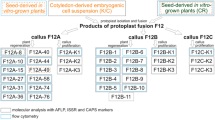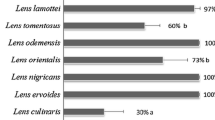Abstract
Albinism is viewed as a major experimental bottleneck during wide hybridization in several species; the phenomenon is also widely reported in androgenesis and doubled haploid cultures. In this study, when chickpea (Cicer arietinum) was crossed with distant wild relatives, C. judaicum and C. pinnatifidum, the only hybrid embryos that survived were those rescued using in vitro techniques. Fourteen to 21-day-old embryos were incubated in ML6 medium with 90 g l−1 sucrose, 1 mg l−1 zeatin and 0.25 mg l−1 indole acetic acid. Germinating embryos were dissected from the ovule and transferred to fresh medium without growth regulators. Later, shoots were micropropagated on solid MS medium, supplemented with B5 vitamins, 30 g l−1 sucrose, 0.1 mg l−1 6-benzyladenine and 0.01 mg l−1 naphthaleneacetic acid. Although some post-hybridization barriers were overcome by rescue in vitro, regenerated hybrid plantlets failed to thrive in culture and few survived transfer to soil. Here we report findings from characterization of this valuable breeding material, as a step towards a better understanding of albinism in chickpea wide hybrids and other plant tissue cultures. Following proliferation, hybrids were phenotyped as green, pale green and albino. Genotype affected pod set, regeneration and albinism. Plastid ultrastructure studies using transmission electron microscopy revealed that thylakoid membranes were well-formed in green hybrids but not in albinos. Spectrophotometric analysis of chlorophyll a, chlorophyll b and total carotenoids revealed that chlorophyll content was three to fourfold lower in albino compared to green hybrids; moreover green hybrids had two to threefold lower total chlorophyll content than in vitro-grown plantlets of their parents. In contrast, carotenoids were higher in some albino phenotypes and lower in others; however overall differences in carotenoids were less marked between all genotypes compared to chlorophyll pigments. Genetic variability between different wide crosses provides an opportunity to select certain chickpea parents and wild species which give rise to more frequent green hybrid regenerants. In future, only these hybrids will be maintained and multiplied for transfer to the glasshouse in our program.




Similar content being viewed by others
References
Abadie JC, Puttsepp U, Gebauer G, Faccio A, Bonfante P, Selosse MA (2006) Cephalanthera longifolia (Neottieae, Orchidaceae) is mixotrophic: a comparative study between green and nonphotosynthetic individuals. Can J Bot 84:1462–1477
Abid G, Muhoviski Y, Jacquemin JM, Mingeot D, Sassi K (2010) Changes in DNA-methylation during zygotic embryogenesis in interspecific hybrids of beans (Phaseolus ssp.). Plant Cell Tissue Organ Cult. doi:10.1007/s11240-010-9878-2
Badami PS, Mallikarjuna N, Moss JP (1997) Interspecific hybridization between Cicer arietinum and Cicer pinnatifidum. Plant Breed 116:393–395
Broughton S (2008) Ovary co-culture improves embryo and green plant production in anther culture of Australian spring wheat (Triticum aestivum L.). Plant Cell Tissue Org Cult 95:185–195
Caredda S, Clément C (1999) Androgenesis and albinism in Poaceae: influence of genotype and carbohydrates. In: Clément C, Pacini E, Audran JC (eds) Anther and pollen: from biology to biotechnology. Springer, Berlin, pp 211–226
Caredda S, Doncoeur C, Devaux P, Sangwan RS, Clement C (2000) Plastid differentiation during androgenesis in albino and non-albino producing cultivars of barley (Hordeum vulgare L.). Sex Plant Reprod 13:95–104
Clarke HJ, Siddique KHM (2004) Response of chickpea genotypes to low temperature stress during reproductive development. Field Crops Res 90:323–334
Clarke HJ, Shan F, Mallikarjuna N, Lulsdorf M, Wilson JG, Siddique KHM (2006a) Unlocking the treasure chest for chickpea improvement: utilisation of annual wild Cicer in wide crosses. In: Mercer C (ed) Australasian plant breeding conference, Christchurch, 18–21 April 2006
Clarke HJ, Wilson JG, Kuo I, Lülsdorf MM, Mallikarjuna N, Kuo J, Siddique KHM (2006b) Embryo rescue and plant regeneration in vitro of selfed chickpea (Cicer arietinum L.) and its wild annual relatives. Plant Cell Tissue Organ Cult 85:197–204
Croser JS, Ahmad F, Clarke HJ, Siddique KHM (2003) Utilization of wild Cicer in chickpea improvement—progress, constraints and prospects. Aust J Agric Res 54:429–444
Gamborg O, Millar RA, Ojima K (1968) Nutrient requirements of suspension cultures of soybean root cells. Exp Cell Res 50:151–158
Iruela M, Rubio J, Cubero JI, Gil J, Mill′an T (2002) Phylogenetic analysis in the genus Cicer and cultivated chickpea using RAPD and ISSR markers. Theor Appl Genet 104:643–651
Jähne A, Lörz H (1995) Cereal microspore culture. Plant Sci 109:1–12
Kaushal P, Malaviya DR, Roy AK, Kumar B, Tiwari A (2005) Trifolium alexandrinum × T. resupinatum—interspecific hybrids developed through embryo rescue. Plant Cell Tissue Organ Cult 83:137–144
Kirk JTO, Tilney-Bassett RAE (1978) The plastids: their chemistry, structure, growth and inheritance, 2nd edn. Amsterdam, Elsevier/North Holland, pp 251–254
Kita K, Kurashige Y, Yukawa T, Nishimura S, Handa T (2005) Plastid inheritance and plastome-genome incompatibility of intergeneric hybrids between Menziesia and Rhododendron. J Jpn Soc Hort Sci 74:318–323
Kumar AS, Gamborg OL, Nabors MW (1988) Plant regeneration from cell suspension cultures of Vigna aconitifolia. Plant Cell Rep 7:138–141
Kumari M, Clarke HJ, Small I, Siddique KHM (2009) Albinism in plants: A major bottleneck in wide hybridization, androgenesis and doubled haploid culture. Crit Rev Plant Sci 28:393–409
Kumari M, Clarke HJ, Francs-Small CC, Small I, Khan TN, Siddique KHM (2011) Albinism does not correlate with biparental inheritance of plastid DNA in interspecific hybrids in Cicer species. Plant Sci 180:561–660
Kuo J (2007) Processing plant tissues for ultrastructural study. In: Kuo J (ed) Methods in molecular biology, vol. 369. electron microscopy: methods and protocols, 2nd edn. Humana Press, Totowa, NJ, USA, pp 35–45
Ladygin VG, Shirshikova GN (2006) The current concepts of functional role of carotenoids in the eukaryotic chloroplasts. Zh Obshch Biol 67:163–189
Lichtenthaler HK (1987) Chlorophylls and carotenoids, the pigments of photosynthetic biomembranes. In: Douce R, Packer L (eds) Methods Enzymol 148:350–382
Mallikarjuna N (1999) Ovule and embryo culture to obtain hybrids from interspecific incompatible pollinations in chickpea. Euphytica 110:1–6
Mallikarjuna N, Hoisington D (2009) Peanut improvement: production of fertile hybrids and backcross progeny between Arachis hypogaea and A. kretschmeri. Food Security 1:457–462
Mallikarjuna N, Jadhav D, Clarke H, Coyne C, Muehlbauer FJ (2005) Induction of androgenesis as a consequence of wide crossing in chickpea. Int Chickpea Pigeonpea Newsl 12:12–15
Mallikarjuna N, Jadhav D, Reddy P (2006) Introgression of Cajanus platycarpus genome into cultivated pigeonpea, C. cajan. Euphytica 149:161–167
Mallikarjuna N, Jadhav D, Nagamani V, Amudhavalli C, Hoisington D (2007) Progress in interspecific hybridisation between Cicer arietinum and C. bijugum. J SAT Agric Res 5:1–3
Murashige T, Skoog F (1962) A revised medium for rapid growth and bioassays with tobacco tissue cultures. Physiol Plant 15:473–497
Nguyen TT, Taylor PWJ, Redden RJ, Ford R (2004) Genetic diversity estimates in Cicer using AFLP analysis. Plant Breed 123:173–179
Pigeaire A, Abernethy D, Smith PM, Simpson K, Fletcher N, Lu C-Y, Atkins CA, Cornish E (1997) Transformation of a grain legume (Lupinus angustifolius L.) via Agrobacterium tumefaciens-mediated transfer to shoot apices. Mol Breed 3:341–349
Redha A, Afzal M (2006) A comparative study of the ultrastructure of spring wheat genotype DH83Z118.32, its albino progeny and their photosynthetic pigments. J Food Agric Environ 4:228–233
Shan F, Clarke H, Plummer J, Yan G, Siddique KHM (2005) Geographical patterns of genetic variation in the world collections of wild annual Cicer characterised by amplified fragment length polymorphisms. Theor Appl Genet 110:381–391
Strzaeka K, Kostecka-Gugała A, Latowski D (2003) Carotenoids and environmental stress in plants: Significance of carotenoid-mediated modulation of membrane physical properties. Russ J Plant Physiol 50:168–173
Thomas JA, Jeffrey AC, Atsuko K, David MK (2005) Regulating the proton budget of higher plant photosynthesis. Proc Natl Acad Sci USA 102:9709–9713
Wang B, Lan T, Wu WR, Li WM (2003) Mapping of QTLs controlling chlorophyll content in rice (Oryza sativa L.). Acta Genet Sinica 30:1127–1132
Wang FH, Wang GX, Li XY, Huang JL, Zheng JK (2008) Heredity,physiology and mapping of a chlorophyll content gene of rice (Oryza sativa L.). J Plant Physiol 165:324–330
Winter P, Pfaff T, Udupa SM, Hüttel B, Sharma PC, Sahim S, Arreguin-Espinoza R, Weigand F, Muehlbauer FJ, Kahl G (1999) Characterization and mapping of sequence tagged microsatellite sites in the chickpea (Cicer arietinum L.) genome. Mol Gen Genet 262:90–101
Yao JL, Cohen D (2000) Multiple gene control of plastome-genome incompatibility and plastid DNA inheritance in interspecific hybrids of Zantedeschia. Theor Appl Genet 101:400–406
Yao JL, Cohen D, Rowland RE (1994) Plastid DNA inheritance and plastome-genome incompatibility in interspecific hybrids of Zantedeschia (Araceae). Theor Appl Genet 88:255–260
Yao JL, Cohen D, Rowland RE (1995) Interspecific albino and variegated hybrids in the genus Zantedeschia. Plant Sci 109:199–206
Acknowledgments
We thank Professor John Kuo for his guidance and Ms Lyn Krilak for technical assistance in the Centre for Microscopy Characterization and Analysis at The University of Western Australia (UWA). We also acknowledge valuable suggestions of Prof. H.K Lichtenthaler, University of Karlsruhe, Germany, regarding chlorophyll pigment analysis. The Grains Research and Development Corporation (Project UWA00091) provided support to develop tissue culture technology and a Cicer interspecific breeding program. The Department of Education, Science and Training, Australia supported the visit of Dr Maya Kumari from India to Australia through an Endeavour Research Fellowship for postdoctoral research.
Author information
Authors and Affiliations
Corresponding author
Rights and permissions
About this article
Cite this article
Clarke, H.J., Kumari, M., Khan, T.N. et al. Poorly formed chloroplasts are barriers to successful interspecific hybridization in chickpea following in vitro embryo rescue. Plant Cell Tiss Organ Cult 106, 465–473 (2011). https://doi.org/10.1007/s11240-011-9944-4
Received:
Accepted:
Published:
Issue Date:
DOI: https://doi.org/10.1007/s11240-011-9944-4




